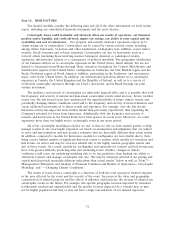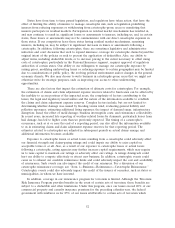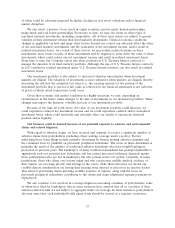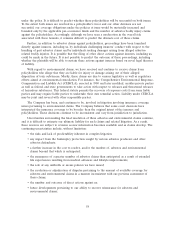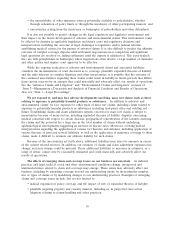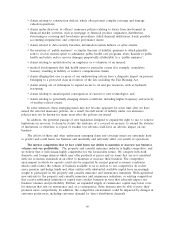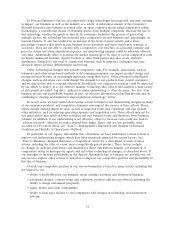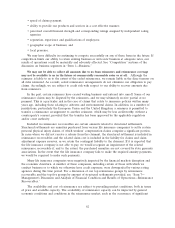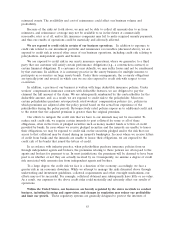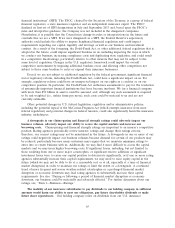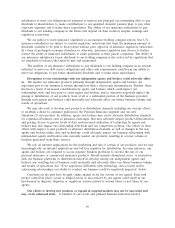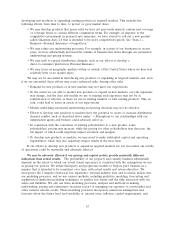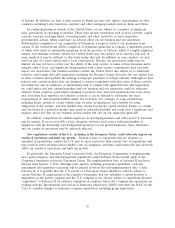Travelers 2013 Annual Report Download - page 70
Download and view the complete annual report
Please find page 70 of the 2013 Travelers annual report below. You can navigate through the pages in the report by either clicking on the pages listed below, or by using the keyword search tool below to find specific information within the annual report.• claims relating to construction defects, which often present complex coverage and damage
valuation questions;
• claims under directors’ & officers’ insurance policies relating to losses from involvement in
financial market activities, such as mortgage or financial product origination, distribution,
structuring or servicing and foreclosure procedures; failed financial institutions; fraud; possible
accounting irregularities; and corporate governance issues;
• claims related to data security breaches, information system failures or cyber-attacks;
• the assertion of ‘‘public nuisance’’ or similar theories of liability, pursuant to which plaintiffs
seek to recover monies spent to administer public health care programs, abate hazards to public
health and safety and/or recover damages purportedly attributable to a ‘‘public nuisance’’;
• claims relating to molestation by an employee or a volunteer of an insured;
• medical developments that link health issues to particular causes (for example, cumulative
trauma), resulting in liability or workers’ compensation claims;
• claims alleging that one or more of our underwriting criteria have a disparate impact on persons
belonging to a protected class in violation of the law, including the Fair Housing Act;
• claims arising out of techniques to expand access to oil and gas resources, such as hydraulic
fracturing;
• claims relating to unanticipated consequences of current or new technologies; and
• claims relating to potentially changing climate conditions, including higher frequency and severity
of weather-related events.
In some instances, these emerging issues may not become apparent for some time after we have
issued the affected insurance policies. As a result, the full extent of liability under our insurance
policies may not be known for many years after the policies are issued.
In addition, the potential passage of new legislation designed to expand the right to sue, to remove
limitations on recovery, to deem by statute the existence of a covered occurrence, to extend the statutes
of limitations or otherwise to repeal or weaken tort reforms could have an adverse impact on our
business.
The effects of these and other unforeseen emerging claim and coverage issues are extremely hard
to predict and could harm our business and materially and adversely affect our results of operations.
The intense competition that we face could harm our ability to maintain or increase our business
volumes and our profitability. The property and casualty insurance industry is highly competitive, and
we believe that it will remain highly competitive for the foreseeable future. We compete with both
domestic and foreign insurers which may offer products at prices and on terms that are not consistent
with our economic standards in an effort to maintain or increase their business. The competitive
environment in which we operate could also be impacted by current general economic conditions,
which could reduce the volume of business available to us as well as to our competitors. In recent
years, pension and hedge funds and other entities with substantial available capital have increasingly
sought to participate in the property and casualty insurance and reinsurance industries. Well-capitalized
new entrants to the property and casualty insurance and reinsurance industries, or existing competitors
that receive substantial infusions of capital may conduct business in ways that adversely impact our
business volumes and profitability. Further, an expanded supply of reinsurance capital may lower costs
for insurers that rely on reinsurance and, as a consequence, those insurers may be able to price their
products more competitively. In addition, the competitive environment could be impacted by changes in
customer preferences, including customer demand for direct distribution channels.
60



